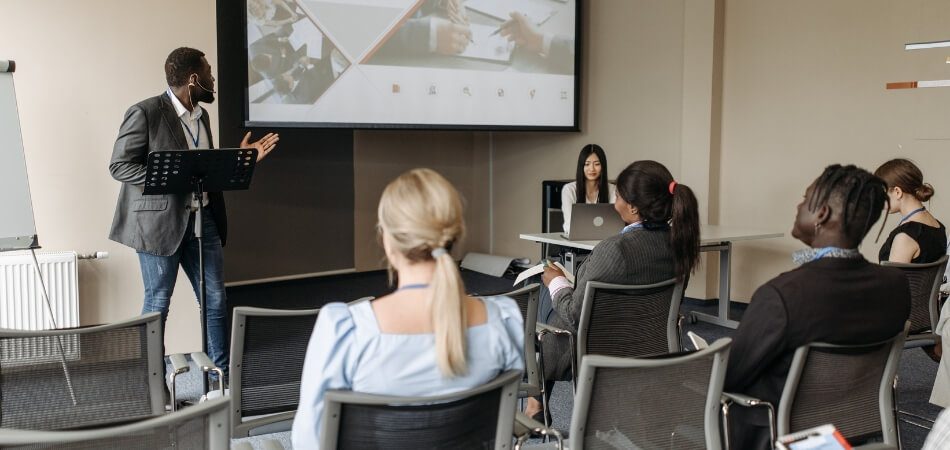Knowing the optimal length for a conference presentation can significantly impact audience engagement and the effectiveness of your message. When preparing for a conference, many participants grapple with the pivotal question: how long is a conference presentation?
The general expectation is a duration of 15-20 minutes. To translate this time into written content, consider the standard rule that a double-spaced page takes approximately 2-2.5 minutes to read aloud.
Therefore, if you want to strike the right balance, aim for an 8-10 page, double-spaced paper. With this guideline, you can ensure your content aligns perfectly with the anticipated timeframe, maximizing clarity and engagement.
Conference Presentation – General Summary
Conference presentations are a cornerstone of academic and professional discourse, facilitating the exchange of groundbreaking ideas and research findings.
When attending a global conference, presentations are the primary method for scholars and professionals to share their findings. Typically lasting 15-20 minutes, these sessions offer concise insights into novel research or methodologies. Such a limited timeframe mandates presenters to be clear, engaging, and brief, ensuring that the audience grasps the essence of their topic.

Diverse in nature, conference presentations can range from keynote speeches by leading experts to interactive poster sessions. These formats cater to different audience sizes and engagement levels, but the goal remains consistent: to impart knowledge and spark discussions. Presenters can bolster their message with visuals and supportive materials, making it more memorable and influential.
One might wonder about the preparation that goes behind a successful presentation. It’s often a meticulous process of refining content, anticipating audience questions, and rehearsing delivery. A good rule of thumb for preparation is to align the written content’s length with the presentation’s duration, ensuring neither rush nor unnecessary elongation.
Why are Conference Presentations Important?
When preparing for a conference presentation, it’s essential to recognize the pivotal role these events play in both academic and industry sectors, raising knowledge dissemination and collaboration.
- Knowledge Sharing: Conference presentations offer a platform for experts to showcase their findings. Attendees gain insights, broadening their understanding of specific topics.
- Networking Opportunities: Presenters and attendees alike can build professional relationships. Such connections often lead to collaborations, partnerships, or future opportunities.
- Skill Enhancement: presentation preparation hones research, writing, and speaking skills. These competencies are valuable in various professional settings.
- Feedback Reception: Presenting allows for immediate feedback from peers and experts. This can help refine ideas or identify potential oversights in one’s work.
- Recognition and Visibility: Conferences provide a stage for researchers and professionals. A successful presentation can boost one’s reputation in their respective field.
How Long is a Conference Presentation?
managing the world of conference presentations requires understanding their typical duration and content expectations.
Presentations usually last between 15-20 minutes in the academic and professional landscape. This time frame is designed to allow for concise, effective communication while preventing information overload. Given this standard, presenters must strategically select and structure their content.
Considering content in terms of written length, an interesting guideline emerges. A double-spaced page typically requires about 2-2.5 minutes to read aloud. Hence, an 8-10 page document often aligns perfectly with the standard presentation duration.
Being aware of this time constraint prompts adequate preparation. By anticipating this length, presenters can ensure a well-paced delivery, maximizing engagement and comprehension from their audience.
Factors Affecting the Duration of a Conference Presentation
The dynamics of conference presentations vary, and several factors influence their duration.
Content Complexity
The intricacy of a topic can significantly influence presentation length. Complex subjects require more time to explain, ensuring audience comprehension. Conversely, straightforward cases might be summarized more swiftly.
Audience Familiarity
Understanding the background knowledge of the audience is crucial. If attendees are well-versed in a subject, the presenter can skip foundational concepts. However, diverse audiences might necessitate a more comprehensive approach.
Format of the Presentation
Different conference formats demand varied durations. Keynote addresses might be longer, offering in-depth insights. Workshop sessions or panels, on the other hand, may have multiple shorter presentations.
Time Allotment by Organizers
Organizers often provide specific time slots to maintain the event’s schedule. These predetermined durations can range from quick lightning talks to extended discussions, guiding the content’s depth and breadth.
Interactive Elements
Including Q&A sessions, discussions, or interactive activities can extend a presentation’s length. Such engagements enrich the learning experience but require additional time to facilitate.
Presenters can tailor their content by considering these factors for optimal audience engagement and effectiveness.
Different Types of Presentations in a Conference
Conferences offer a myriad of presentation formats, each tailored to specific communication and engagement objectives.
Keynote Addresses
Keynote speeches set the tone for the entire event. Renowned experts or leaders usually deliver these, sharing insights on overarching themes. Such presentations aim to inspire, motivate, or provide a comprehensive overview of the event’s central topic.
Oral Presentations
These are standard sessions where researchers or professionals present their findings. The format is formal, with slides often accompanying the talk. Attendees get insights into specific studies, projects, or innovations, making it a fundamental conference component.
Poster Sessions
Presenters display their work on large posters in a dedicated area. This format facilitates more personal interactions between the presenter and attendees. Participants can walk around, explore various signs, and engage in one-on-one or small group discussions.
Workshops
Workshops are hands-on sessions focusing on skill-building or in-depth exploration of a topic. They often involve group activities, discussions, and practical tasks. This interactive format ensures attendees gain knowledge and practical experience or skills.
Panel Discussions
A group of experts discusses a specific topic or set of topics in front of an audience. The moderator facilitates the conversation, ensuring diverse viewpoints are covered. Audience members often have the opportunity to pose questions, making it a two-way communication platform.
Recognizing these distinct formats allows attendees to manage conferences effectively and presenters to choose the best approach for their content.
Bottom Lines
Managing the world of professional and academic events often leaves individuals pondering the ideal content delivery duration. Amidst this, the burning question arises: how long is a conference presentation? The answer rests within a general understanding that presentations typically span 15-20 minutes.
This time frame is no mere coincidence; it’s tailored to ensure clarity and maintain audience engagement. An 8-10 page double-spaced document often aligns perfectly with this, offering a balance between detail and brevity.
By adhering to this guideline, presenters can effectively share their insights, making a lasting impact while respecting the event’s time constraints.






